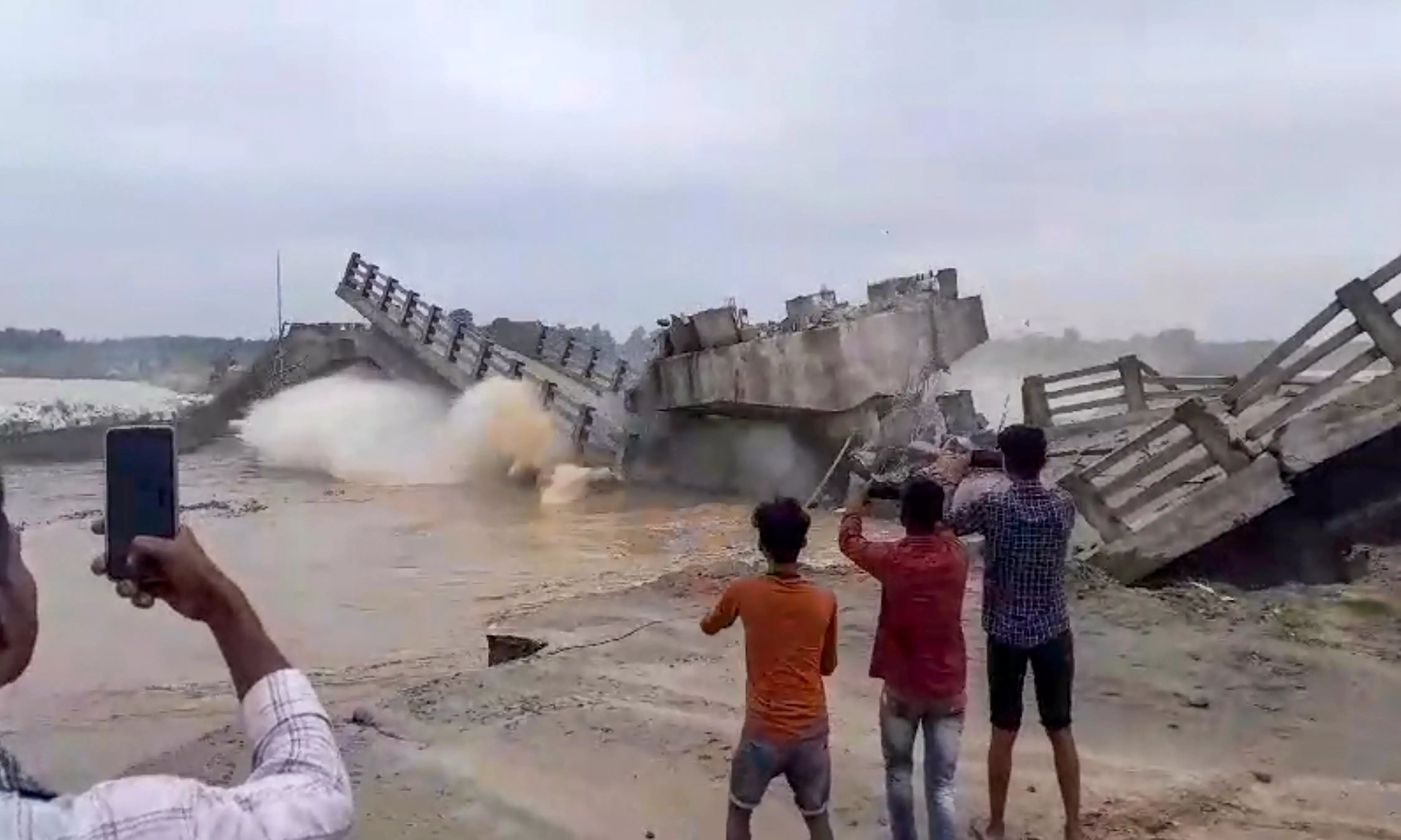
10 collapses in 15 days: Why Bihar's bridges are crumbling like cookies
As Nitish govt goes into damage control mode, disasters expose nexus between govt officials and contractors, leading to compromises on quality of construction

In just a fortnight, 10 bridges have collapsed in Bihar, posing a serious infrastructure challenge to the Nitish Kumar government and exposing the nexus of government officials and private contractors.
Chief Minister Nitish Kumar is credited with building a huge network of roads, bridges and culverts over the past 19 years in Bihar. He used to claim that he has built roads and bridges on such a massive scale that people can now reach Patna from remote corners of the state in just six hours. This was often his poll plank in Assembly elections.
Reputational damage
The crumbling of bridges has lowered his image no end. Though Nitish has ordered a thorough investigation into the reasons behind collapse of bridges, a blame-game is on among officials, engineers and contractors.
The customary probe will yield no concrete results and those who have been affected will continue to suffer, it is feared.
In Bihar, bridges are constructed by different departments including Rural Works Department, Rural Development Department, Road Construction Department and Bihar Rajya Pul Nirman Nigam, depending on the projects falling under the Pradhan Mantri Gram Sadak Yojana, Mukhya Mantri Sampark Yojana, and highway projects funded by the Centre.
Hence, the blame tends to get laid simultaneously everywhere and nowhere.
Not a recent trend
But Bihar has not been a stranger to such bridge collapses. The collapse of bridges – big and small, old and new – has been happening with alarming regularity.
Nine bridges crumpled and sank in 2023, while the number was eight in 2022.
It's not just bridges. There have been frequent infrastructure-related incidents like caving in of roads and highway stretches being washed away in the state.
What has caused huge embarrassment to the government is the fact that three bridges fell in a span of just 36 hours in Saran district. A 15-year-old bridge across Gandaki, a rivulet, collapsed on Thursday morning. A day before, two bridges crumbled at Janta Bazar and Lahladpur in the same district.
Some of these bridges, like the one in Saran, are nearly 100 years old, while another was just 30.
Recent collapses
Beginning on June 18 in Aararia district, seven more bridges collapsed in Madhubani, East Champaran and Kishanganj.
In March this year, the girder of an under-construction bridge across River Kosi in Supaul district collapsed, killing a worker and leaving 10 injured. It is being constructed at an estimated cost of Rs 1,700 crore under the Centre's Bharatmala project.
Once completed, the bridge, for which Nitish laid the foundation in 2014, will be bigger than the Bhupen Hazarika Bridge in Assam.
The series of bridge collapses has raised concerns about the structural integrity of other bridges, old and new.
Possible reasons
The prevalent contractor-engineer-officer nexus is identified as a major cause but no one takes responsibility for such repeated failures.
In a bid to extract political mileage and success in elections, the high-value infrastructure projects are often rushed through without proper structural inspections, quality audits, or safety monitoring. It eventually results in flawed design and poor construction quality.
The exact cause of the collapse of bridges in Saran remains unknown but officials prima facie attribute it to the recent de-siltation work and subsequent heavy rainfall resulting in the erosion of base of pillars.
“These structures don’t seem to have been constructed as per the laid-down parameters and the foundations were not deep enough leading to the collapse,” said Additional Chief Secretary of the Rural Works Department, Chaitanya Prasad.
Poor quality
Technical experts attribute the crumbling of bridges to the use of sub-standard materials and violation of the prescribed ratio of cement, sand and stone chips. “Ideally, it should be in the ratio of 1:1.5:1," said retired engineer Tuntun Jha, adding that it's often not followed.
A political nexus is also being alluded to. A private construction company had purchased bonds worth Rs 75 lakh on a single day on May 10, 2019. The company constructed the Bhagalpur-Khagaria bridge, parts of which collapsed twice in 2023, on April 30 and June 4.
Bihar also has a poor record of bridge maintenance, thanks to policy gaps. While the Water Resources Department has a maintenance policy, the Rural Works Department and others have none.
According to official records, Bihar has a network of 1.5 lakh km of road and 30,000 km of national highways with thousands of small bridges and culverts. In the absence of a maintenance policy, their upkeep is not done at regular intervals, adhering to the guidelines of the Indian Bridge Management System.
PIL filed
A Public Interest Litigation (PIL) petition has been filed in the Supreme Court seeking directions to the Bihar government to conduct a structural audit of all existing and under-construction bridges in the state.
It also seeks a set of guidelines and policies to ensure the real-time monitoring of the construction works including bridges.
The petition states that the total flood-affected area in Bihar is 68,800 sq km, amounting to nearly 73 per cent of the total geographical area. “Therefore, the lives of people in the flood-affected areas are at stake in the absence of a monitoring system,” the petition says.
Nitish orders survey
Nitish has ordered a detailed survey of all the old bridges and directed the Rural Works Department and Road Construction Department to identify bridges that require immediate repair and maintenance work.
The Water Resources Department has instructed officials to monitor the water levels of rivers in North Bihar due to heavy rainfall in their catchments areas in Nepal.
Unless the state government goes beyond optics management, the state could well see its infrastructure crumbling even more in the days to come.

